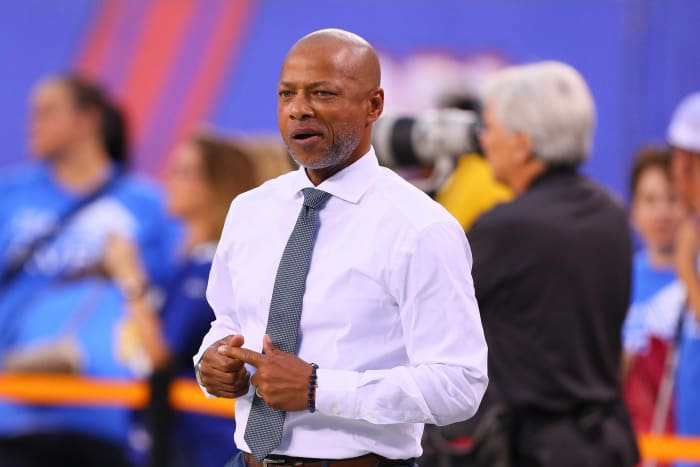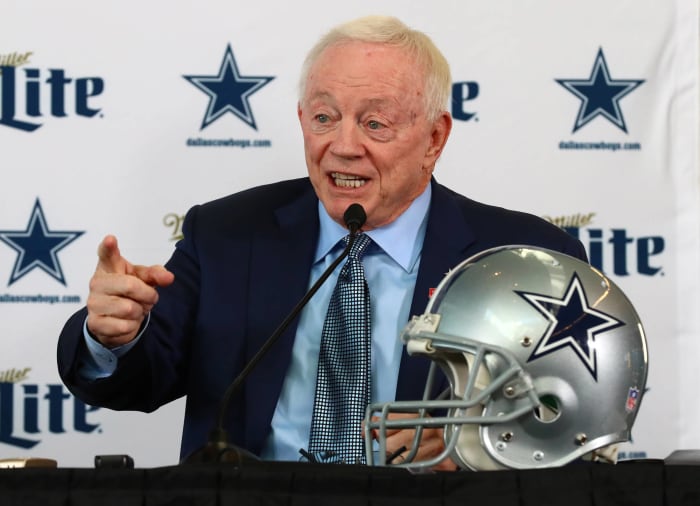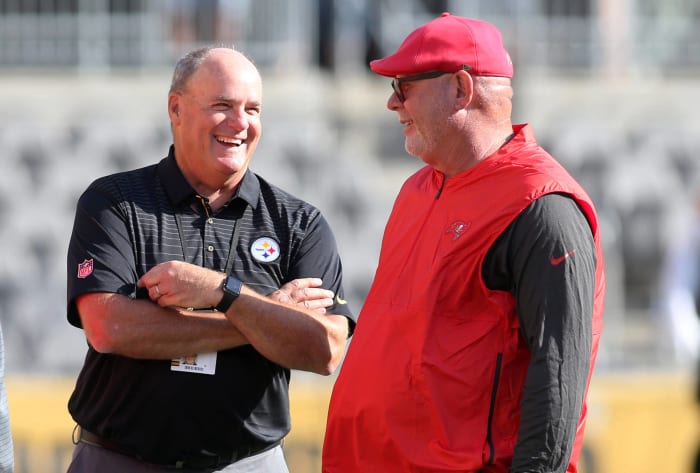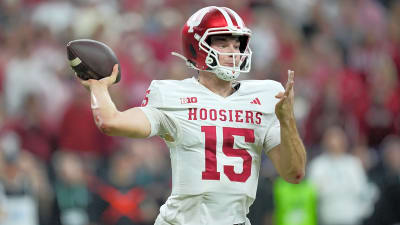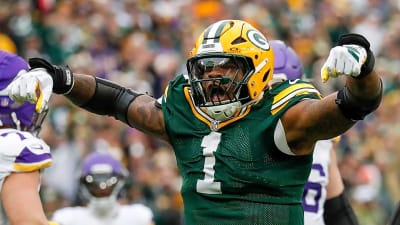Here are the personnel czars that previously led teams to sustained success. No coach-GMs are included here, just pure front office execs who assembled quality rosters.
Rich Graessle/Icon Sportswire
Yes, the Giants' Super Bowl XLII-winning team involved numerous Ernie Accorsi-acquired talent, as it came in Reese's first season. But the ex-Accorsi lieutenant built the Super Bowl XLVI team largely on his own. Players like Jason Pierre-Paul, Victor Cruz and three fifths of the O-line were Reese acquisitions. Had Plaxico Burress not accidentally shot himself in 2008, a loaded Giants squad -- one better than 2007's title team -- could have repeated . The back half of Reese's run creates complications, as O-line issues and the Ben McAdoo promotion -- which led to the infamous Eli Manning benching and Reese's firing -- proved costly.
Jerome Davis-Icon Sportswire
Though the Steelers made multiple playoff brackets in the 1980s, they were in decline by decade's end. Promoted to Steelers front office boss in 1991, Donahoe hired Bill Cowher to succeed Chuck Noll weeks into his tenure. The Steelers made the next six playoff brackets and went to three AFC title games and Super Bowl XXX during Donahoe's nine-year stay. Donahoe's Kevin Greene signing ignited the "Blitzburgh" defense, and acquisitions of Jerome Bettis and Alan Faneca set up Steeler run games well into the aughts. Donahoe did not duplicate his success with the Bills, but the Steelers have not looked back.
Ron Chenoy-USA TODAY Sports
The final years of Elway's 10-year GM tenure obviously dinged his stock, but the Broncos are the only franchise to see a Super Bowl-winning QB retire. It's happened twice, the first with Elway. But the Hall of Famer-turned-GM lured Peyton Manning to Denver and built a strong team around him. One of the better roster reloads in NFL history came in the mid-2010s in Denver. After the Seahawks walloped an injured and offense-oriented team, Elway went to work and added defensive pieces that formed a dominant group by 2015. As Manning sharply declined, that defense carried a wildly different Broncos team to a one-sided Super Bowl 50 win. That compensates for Denver's late-2010s swoon.
4 of 25
22. Carl Peterson
Kenny Felt-Icon Sportswire
The Chiefs resided off the competitive radar for most of the 1970s and '80s. Peterson's 1989 arrival restored the former AFL power to an upper-echelon AFC operation almost immediately. The ex-USFL champion exec built Super Bowl-caliber defenses during Marty Schottenheimer's tenure, and the 1993 acquisitions of Joe Montana and Marcus Allen represented peak Chiefs relevance between Super Bowl IV and Patrick Mahomes. The Chiefs made seven playoff berths in the '90s and built an all-time offensive line in the aughts. Playoff wins proved elusive during Peterson's 20-year tenure, but he deserves credit for leading a revival effort.
Matthew Emmons-USA TODAY Sports
Jones deserves blame for the 1994 breakup with Jimmy Johnson. The Cowboys have not been the same. But they did win a Super Bowl post-Johnson and have made the playoffs 15 times since the seminal divorce. Jones authored big hits and big misses at wide receiver and kept Jason Garrett too long. But the Cowboys landed franchise QBs in unexpected places ( Tony Romo, Dak Prescott) and built the 2010s' defining offensive line -- during a strong decade for Dallas first-round picks. The Cowboys could use more non-Jones-family help and do have a 29-year NFC championship game drought. But some credit is due here.
Mark Hoffman-USA TODAY Sports
On one hand, Thompson landed a top-five all-time quarterback talent with his first draft pick and fortified a roster around him to win Super Bowl XLV and form a 15-1 team the following year. On the other, the Packers GM's rigidity when it came to outside acquisitions did not give Aaron Rodgers enough support. That led to some bitter playoff exits and Rodgers' Packers career wrapping with one Super Bowl appearance. A two-time Executive of the Year, Thompson did change the Packers defense by signing Charles Woodson. This helped Brett Favre guide the team to the 2007 NFC championship game, but Green Bay's defense slipped as the 2010s wore on.
7 of 25
19. Carmen Policy
Justin Sullivan-Getty Images
Although Policy was with the 49ers for much of their 1980s dynasty, his time with autonomy came in the '90s. Policy kept the 49ers in top gear into the salary cap era. He stocked the team with key draftees (Ricky Watters, Bryant Young, Dana Stubblefield), and a Deion Sanders-led 1994 free agency class helped the 49ers overtake the Cowboys and dominate in Super Bowl XXIX. (Though, sending Charles Haley to Dallas became a problem.) The 49ers made the playoffs in each of Policy's seven seasons, and his Terrell Owens Round 3 pick provided all-time slot value. While on Bill Walsh's level, the 49er dynasty's back half was not too shabby.
Gary A. Vasquez-Imagn Images
Ownership giving Snead the chance to hire a second coach, after Jeff Fisher mediocrity, changed the Rams' fortunes and revitalized the Los Angeles market. Snead's Sean McVay hire is among the best in NFL history. The Rams had missed 12 straight playoff brackets; under McVay, they are 6-for-8 with two Super Bowl berths. Snead's "eff them picks" mantra took off, as trades helped the Rams form both their Super Bowl rosters. The second one included four first-rounders dealt for Matthew Stafford and Jalen Ramsey. The Rams reloading after a woeful title defense also bolsters Snead's case, as Day 2 and Day 3 draft choices continue to provide vital support. Drafting Aaron Donald in 2014: also good.
Al Messerschmidt-Icon Sportswire
The second-generation NFLer completed one of the most difficult rebuilds in NFL history , lifting the Buccaneers out of their decade-plus laughingstock status. McKay's first two draft choices -- Warren Sapp and Derrick Brooks, in 1995 -- are in the Hall of Fame. So is his first coaching hire ( Tony Dungy). After 14 straight losing seasons, the Bucs made the playoffs five times from 1997-02. Ownership went over McKay's head in trading for Jon Gruden, and although it helped secure a championship, the McKay-Gruden 2003 split ended the organization's time as a true contender. McKay's Falcons GM stint included sporadic success and splashier headlines.
Derick E. Hingle-USA TODAY Sports
Two Loomis moves overshadow everything else from a 20-plus-year GM tenure, each coming in 2006. After a Hurricane Katrina-marred 3-13 season, Loomis hired Sean Payton and beat out the Dolphins for free agent Drew Brees. The Saints won one playoff game prior to these moves; they now have 10 postseason wins -- including Super Bowl XLIV -- and saw Brees torch NFL passing marks. Loomis was not shy about equipping Brees with help, continually taking swings despite perennial cap constraints. This regime could well have secured multiple additional Super Bowl berths. January luck burned the Saints. Loomis' 2017 draft class refueled the operation; his refusal to rebuild post-Payton has proven questionable.
Trevor Ruszkowski-USA TODAY Sports
It is important to note the Chiefs remain an Andy Reid-run organization, and GM predecessor John Dorsey drafted their dynasty's three cornerstones (Patrick Mahomes, Travis Kelce, Chris Jones). But Veach's work on the contract front proved pivotal. Promoted in 2017, Veach is credited with pounding the table for Mahomes ahead of Dorsey's last draft. He also rebuilt a woeful defense into one capable of supplementing Mahomes after the offense declined post-Tyreek Hill. After the Buccaneers hounded Mahomes in Super Bowl LV, Veach used the 2021 offseason to build one of the NFL's best O-lines. Two more Super Bowl wins followed. as Mahomes' 10-year extension also remains the gift that keeps giving.
Joe Nicholson-USA TODAY Sports
Schneider and Pete Carroll lifted the Seahawks to their highest point; the franchise was a play-calling snafu from back-to-back Super Bowl wins. In Schneider's first three drafts, Seattle selected three likely Hall of Famers (Richard Sherman, Bobby Wagner, Russell Wilson) after Round 1 to form a core that dominated the NFL for a time. Seattle's four straight defensive scoring titles are unparalleled, and the 2013 Seahawks were the best 2010s team . Trades for Percy Harvin and Jimmy Graham did not pan out, and Schneider missed on some first-round picks. But the haul he received in the 2022 Wilson trade -- highlighted by two first-round picks -- aged spectacularly.
Charles LeClaire-USA TODAY Sports
In power with multiple titles from 2000-2022, Colbert stood as a steady hand for the modern Steelers. Usually swiping left on free agency, the Steeler boss extended essential players and did well to replace the others. Landing Troy Polamalu and Ben Roethlisberger in consecutive drafts, Colbert also formed an unrivaled wide receiver assembly line. The Steelers tabbing a 34-year-old Mike Tomlin to replace Bill Cowher became a defining modern-era hire, and the Colbert-Tomlin partnership produced two Super Bowl berths and zero losing seasons. The Colbert-era Steelers endured letdowns and an Antonio Brown meltdown, and Colbert's final first-round pick (Kenny Pickett) bombed. But for sustained success, few rival the Steelers.
14 of 25
12. Don Klosterman
Icon Sportswire
An AFL power broker who helped shape Chiefs Super Bowl teams, Klosterman was GM of the Oilers, Colts, and Rams. Following Don Shula's exit, Klosterman's first Colts year doubled as the franchise's first Super Bowl win. But the Colts and Rams owners swapping franchises in 1972 led to a 10-year tenure featuring mostly successful Los Angeles squads. Klosterman bolstered the Rams with high-profile trades -- among them the hauls collected for QBs Roman Gabriel and John Hadl. Though QB issues persisted, the Rams won the NFC in 1979. From 1967-79, Klosterman's three franchises made 12 playoff berths and eight league or conference championship games.
15 of 25
11. Ernie Accorsi
Rich Graessle-Icon Sportswire
Although Accorsi was not with the Giants when they stunned the unbeaten Patriots in Super Bowl XLII, 17 of Big Blue's starters that night arrived during his 10-year tenure. Resigning his Colts GM post soon after ownership traded John Elway, Accorsi elevated the Browns into Elway's chief 1980s rival. On the wrong end of two "The" games, those Browns came agonizingly close to multiple Super Bowls. Accorsi built two Giants Super Bowl nuclei, assembling much of the 2000 NFC champion team and reloading after being on the other end of a QB power play. Accorsi's 2004 trade for Eli Manning enabled two future Giant victory parades.
Rich Graessle-Icon Sportswire
One of Al Davis' top lieutenants for much of the Raiders' rise, Wolf led the resurgence of a storied Packer franchise after a grim post-Vince Lombardi two decades. Within months of becoming Green Bay's GM, the Hall of Famer pilfered Brett Favre from the Falcons. A year later, in 1993 -- modern free agency's first year -- Wolf landed Reggie White, the best free-agent defender ever. The Packers went from zero non-strike-season playoff berths in 20 years to zero losing seasons during Wolf's nine-year stint, ending the NFC's Cowboys-49ers arms race by usurping both en route to back-to-back Super Bowls in 1996-97.
Bettmann-Getty Images
Finks was never a Super Bowl champion, but the Hall of Famer played an essential role in three franchises' climbs. Although Bud Grant had the final say during Finks' Vikings' GM run, Finks' Chicago work set up arguably the greatest team in NFL history. The nine-year Bears GM drafted Hall of Famers Walter Payton, Dan Hampton, and Mike Singletary -- along with 16 other 1985 Bears starters -- before resigning in '83. Resurfacing with the Saints in 1986, Finks turned the NFL's saddest-sack franchise into a winner. New Orleans was 0-for-19 in playoff berths before Finks, who had them in four playoff fields during a seven-season run.
Bill Streicher-USA TODAY Sports
A GM by 34, Roseman has produced a wildly successful second act. After losing a power struggle with Chip Kelly, Roseman was nearly booted in 2015. Once Kelly's HC-GM year backfired, Roseman returned and assembled two Super Bowl champions. Building around Carson Wentz's rookie contract, the Eagles managed to win without their would-be MVP QB due to the roster strength. Always fortifying Philly's lines -- multiple Hall of Famers will probably emerge from those efforts -- Roseman rebooted quickly around second-round QB Jalen Hurts. Roseman stole A.J. Brown via trade and pilfered Saquon Barkley from the Giants, helping the Eagles emphatically exact revenge on the Chiefs in Super Bowl LIX.
Focus on Sport-Getty Images
The Giants once slogged through a 17-year playoff drought; Young's tenure ended that quickly. Hired soon after 1978's "Miracle in the Meadowlands," Young had the Giants in the 1981 playoffs -- buoyed by that year's rather notable Lawrence Taylor draft choice -- and teamed with Bill Parcells to make the team a 1980s power. The Giants stampeded to a championship, capped by a masterful performance from Young's first draftee (Phil Simms), in 1986 and won another four years later, denying a favored 49ers team a threepeat. A five-time NFL Executive of the Year, Young hired two NFL Coach of the Year honorees (Dan Reeves, Jim Fassel) post-Parcells en route to the Hall of Fame.
George Gojkovich-Getty Images
A brilliant talent evaluator who ran the Steelers' drafts for 20 years, Haley was essential in forming one of the NFL's defining nuclei. The Steelers' 1974 draft changed the game, with Haley's haul including four Hall of Famers -- Lynn Swann, Jack Lambert, John Stallworth, Mike Webster -- that helped the Joe Greene- and Terry Bradshaw-led team to four Super Bowl titles. Haley drafted numerous other Steel Curtain-era starters, including Hall of Famers Jack Ham and Franco Harris, and landed Rod Woodson in 1987. With no free agency in this era, draft czars were vital. Haley has a strong case as a Hall of Fame contributor.
Trevor Ruszkowski-USA TODAY Sports
Newsome's first Ravens draft included two first-ballot Hall of Famers -- Jonathan Ogden and Ray Lewis -- and he later selected the best safety ever ( Ed Reed). Lamar Jackson became Newsome's parting gift. The NFL's first Black GM, Newsome ran the Ravens from 1996-2018. He assembled an all-time defense, with Baltimore's 2000 unit carrying an offensively limited team to a Super Bowl romp, and zagged by hiring a special teams coach in John Harbaugh. Hoarder of compensatory picks, Newsome continued to replenish Ravens rosters after letting free agents walk. This process helped lead to the franchise's 2012 championship. Newsome's final first-round pick -- Lamar Jackson -- is now a two-time MVP.
22 of 25
4. Bobby Beathard
Stephen Dunn-Getty Images
Beathard formed an unorthodox NFC juggernaut. Big on trade-downs, the Washington GM used two of the three first-round picks he made in 12 drafts on Hall of Famers (Art Monk, Darrell Green) and found the top "Hogs" via third-round pick (Russ Grimm), trade (Jim Lachey) and via undrafted free agency (Joe Jacoby). Joe Theismann's injury led to a Bucs castoff (Doug Williams) being named Super Bowl MVP; Beathard also equipped his GM successor with future Super Bowl MVP Mark Rypien, a Round 6 pick. His Joe Gibbs hire keyed an unorthodox 1980s power. Beathard rebuilt the Chargers in the '90s, drafting Junior Seau (and later Ryan Leaf) and turning a 10-year Bolts playoff drought into the franchise's only Super Bowl berth.
Focus on Sport-Getty Images
Judging only Davis' GM work, the Raider icon compiled a case as the best ever. Davis hired John Madden, formed a four-Hall of Famer O-line at one point, acquired three legendary wideouts (Fred Biletnikoff, Cliff Branch, Tim Brown), and made the Raiders the most identifiable NFL brand. They won 11 games 11 times from 1967-85 -- beginning the run well before the 16-game era -- and were in 11 AFL or AFC title games. Davis' reclamation-project hot streak provided elite support for the three Super Bowl champions. An erratic second half of Davis' career, however, did steer the franchise's descent. But few organizations have matched the Raiders' initial staying power.
Kirby Lee-USA TODAY Sports
Six-time Executive of the Year, Polian excelled with three franchises in a well-rounded career. The Bills went 2-14 in 1985, before Polian and Jim Kelly's 1986 arrivals. The GM transformed the dormant franchise into the premier AFC outfit, drafting Thurman Thomas (in Round 2) and numerous starters to allow for an unmatched four straight Super Bowl appearances. Hired as the Panthers' first GM, Polian loaded up Carolina's roster with free agents that had the team in the NFC title game in Year 2. The Colts followed a 3-13 season by drafting Peyton Manning over Ryan Leaf, hiring Tony Dungy, and building a roster Manning could lift to two Super Bowls.
Trevor Jones-Getty Images
Joining Tom Landry and scouting icon Gil Brandt as the troika that turned the Cowboys into one of the world's most recognizable teams, Schramm led the franchise's front office for its first 29 years. During that span: 20 consecutive winning seasons, five Super Bowl appearances, and draft revolutionization that ended with the Schramm-era Cowboys selecting nine Hall of Famers. Schramm acquiring top-five picks from the Giants and Seahawks in a three-year span netted them, Randy White and Tony Dorsett, extending the dynasty into the 1980s. The Cowboys became American royalty under Schramm, helping elevate the NFL in the process.
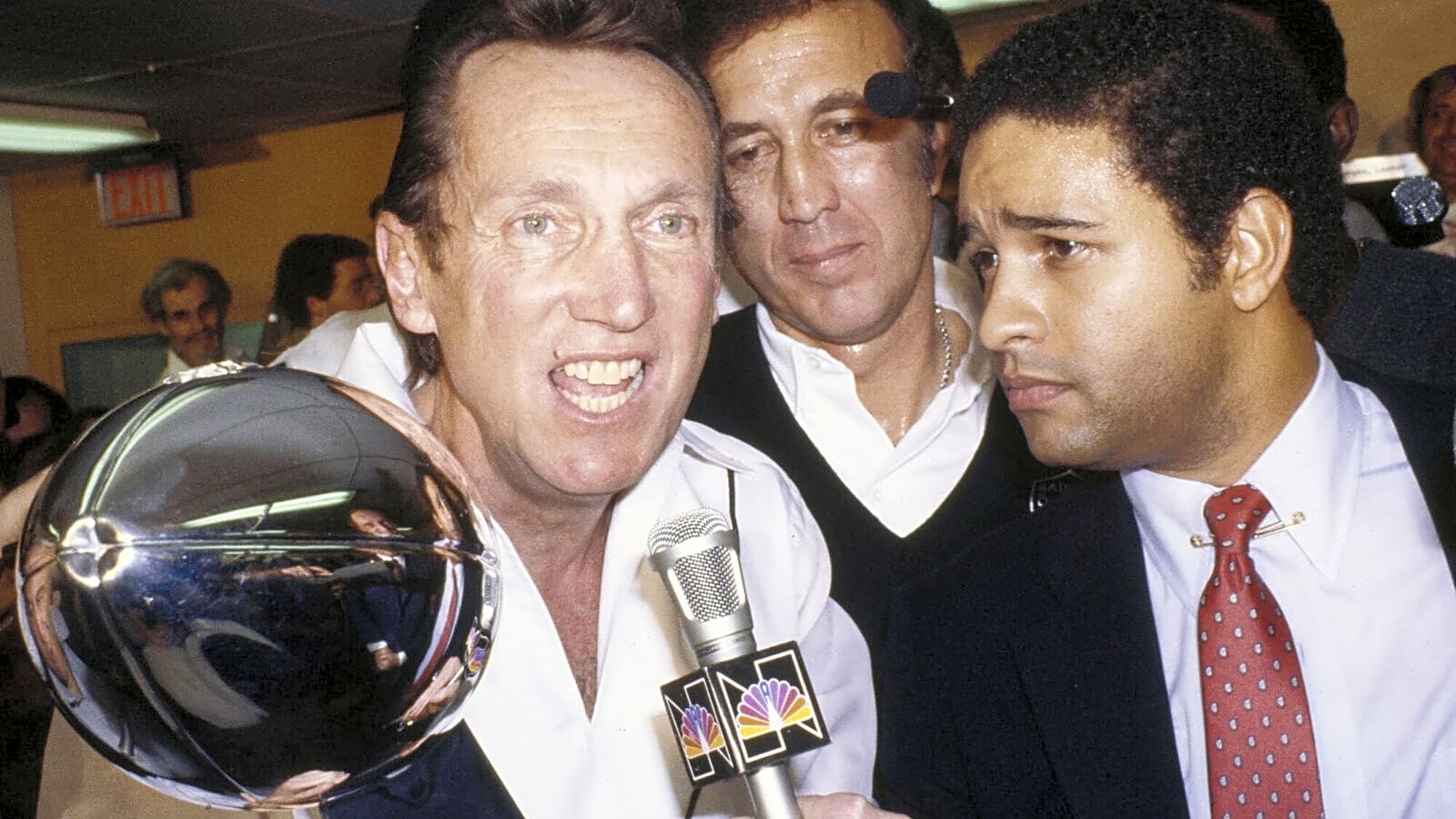
 +
+
